
Shielding our eyes as if saluting the sun, we trundle our bags to the car rental place, whimsically named Broome Broome. A set of keys for a brand-new Toyota HiLux is casually lobbed our way. Now, I haven’t the faintest clue how to operate this 4x4 beast off-road or whether it runs on petrol, diesel, or sheer optimism. But there are no instructions, no vehicle checks, not even a casual “Good luck, mate.” Broome Broome must be the most relaxed car rental agency in Australia (possibly the world). If you are headed out this way, ensure your rental has a lockable canopy. You don’t want to leave anything in the cabin due to theft.
Here we embark on our Indigenous Road Trip, navigating the Broome/Dampier Peninsula.
Before we venture onto the dusty red dirt tracks in our shiny rental, we decompress from our long flight at Cable Beach Resort. It’s a breezy 10-minute drive from Broome’s town centre and ideal for a touch of luxury before the adventure. Indeed, the poolside flora is a spectacle unto itself – alien landscape meets tropical fever dream. The frangipani leaves are so large they’re practically waving at us, and the boab trees are like oversized bonsai. Our room is smartly furnished with balconies and curtains that twitch in the coastal breeze. Moreover, the resort’s location is excellent. Our evening destinations are within walking distance, so we can ditch the Hilux and ‘relux’ with a drink.
We set out to explore Broome town proper. Here, ‘corrugated iron chic’ meets Chinese and Indigenous Australia. Dreadlocks and sarongs brush elbows with pearls and pink diamonds – a cultural mash-up that defies categorisation. Broome is a sensory assault, leaving you wondering if you’ve wandered into an outback bazaar or a Pigram Brothers song.
Lunch is at Haven Café on the main drag, where we tuck into a Southwest Bowl with pulled pork and corn salsa. This alfresco dining is ideal for people-watching, offering a front-row seat to the local theatre that is Broome. Around here, wearing enclosed shoes is like donning a tuxedo.
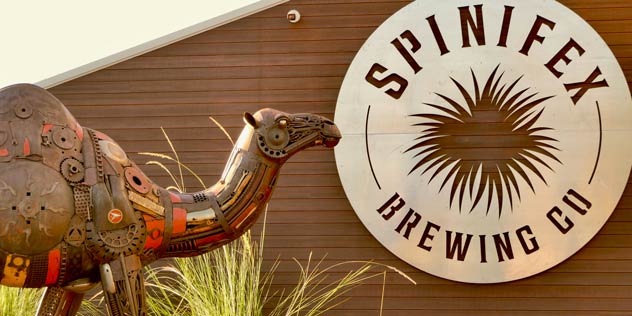
In the evening, we take a leisurely stroll from the resort to the Spinifex Brewery. Originally spearheaded by First Nations local, Mick Little, this Aboriginal enterprise masterfully blends local botanicals with age-old brewing techniques to create a craft beer that embodies the essence of the tropics. The result? The ‘Kimberley Crisp’, a refreshing taste of the land’s history and heritage.
As we stroll to dinner, we encounter a surreal sight: a team of camels being casually led down a suburban street. These desert dwellers stop at Spinifex Brewery each night for a feed of wort and we’d like to hang around but we’re on a mission, lured by the promise of a magical sunset over Broome’s famous Cable Beach.
This beach’s storied past stretches beyond its stunning 22km of pristine white sand and turquoise waters. Named after the undersea telegraph cable laid between Broome and Java in 1889, it’s been a place of connection – first for telegraph messages, and now for those seeking beauty and serenity. It’s also historically significant for the local Yawuru people, whose ancestral lands encompassed this breathtaking coastline. Their stories and traditions are woven into the fabric of the beach, lending it a profound sense of place.
Upon arrival, we’re greeted by a scene straight from a Hollywood rom-com: a couple slow-dancing in the amber glow of the long sunset, their silhouettes swaying softly against the vivid hues of the sky. Nearby, a lone piper stands in a singlet and thongs, serenading the sun’s slow descent. It’s a moment that perfectly encapsulates Broome’s quirky charm – where camels, craft beer, and bagpipes all make sense.
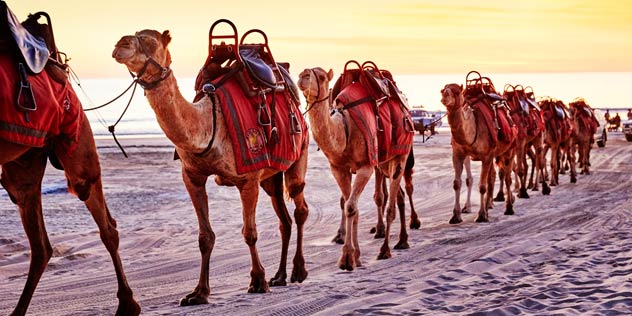
From Cable Beach Restaurant, we take in the view as the ozone-rich scent of the sea fills our nostrils. We sip fruity cocktails and watch the sky transform into an upturned glass of mango juice – vibrant, golden, impossibly vast.
The seafood is nothing short of exquisite, each dish a testament to the ocean’s bounty. And if Cable Beach Restaurant were parked at Bondi, you’d need to remortgage your house to afford it. But here, amidst the laid-back splendour of Broome, it’s a culinary bargain in paradise.
The following morning we meet Jayden and Raf from Bunda Bunda Tours. Jayden, a Jabirr Jabirr and Ngumbarl man, leads us on a cultural tag-along tour through the breathtaking coastal country of the Dampier Peninsula. In our HiLux we navigate bumpy dirt tracks, exploring remote sandy beaches, freshwater springs, incredible mangrove ecosystems, and secret fishing spots that don’t exist on any map.
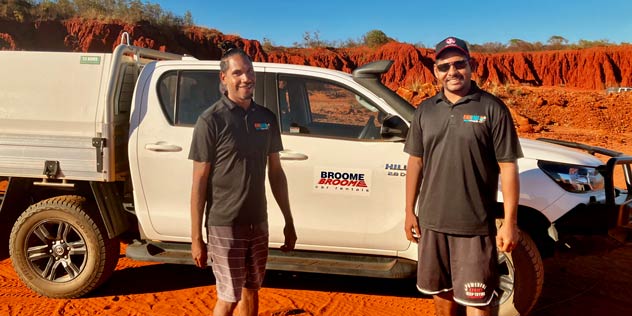
But this is where things get hairy. I’m no outback hero. I’m simply a nervous urbanite clinging to the wheel of a polished rental, navigating some of the wildest roads in Australia.
As our rental rattles itself to death, every bump and jolt reminds me how utterly out of my element I am. But once we reach our remote destination, all the dust and anxiety melt away. We’re treated to Dreamtime stories that echo with the ancient wisdom of the land, and we’re invited to join a very authentic First Nations experience. The boys demonstrate their skills, collecting mud mussels and seasnails, and Jayden spears a long tom with the grace and ease of Captain Ahab, leaving us in awe. Suddenly, the wild roads and my rattled nerves seem like a small price to pay for this rare, enriching, authentic experience.
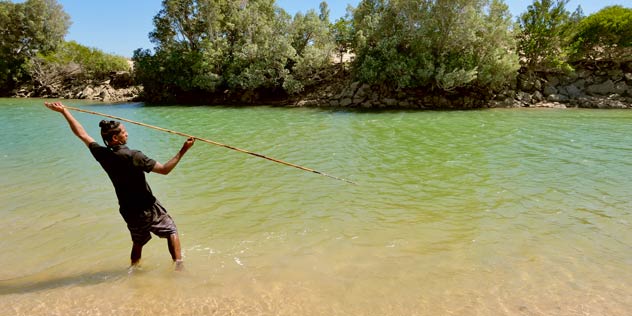
We depart Bunda Bunda Tours and set out on our quest to find tranquil Mercedes Cove. With no GPS and armed with nothing more than a map of Australia that might as well have been drawn in crayon, the journey quickly becomes an exercise in stress management. More dirt tracks make us question the sanity of anyone who calls these ‘roads’. I can only imagine what navigating these roads must be like in the wet season.
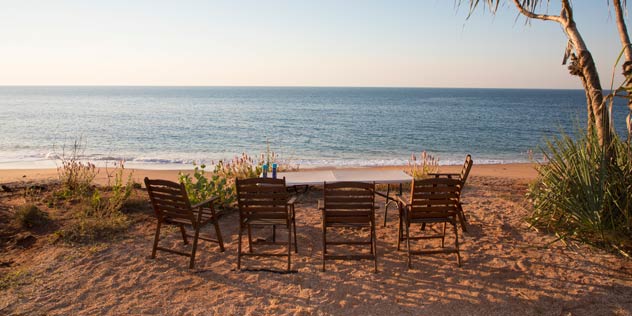
After an eternity of bumping along and taking wrong turns, we finally arrive at Mercedes Cove Coastal Retreat, owned by Bardi woman Pat Channing. We’re rewarded with uninterrupted views of the ocean and a private sandy beach perfect for a swim. The sea is blissfully warm. We towel off to watch the sun set behind the ancient Chimney Rocks. It’s a postcard-perfect setting, and our rather glamorous eco-tent feels like luxury after the day’s adventures.
Before departing Mercedes Cove the following morning, I ask caretaker Tony for directions to Cygnet Bay Pearl Farm, where we’re scheduled to meet our next First Nations guide. Tony asks about the meeting time, and I naively reply, “In 45 minutes.” He detonates with laughter. Apparently, even if I channelled my inner Lewis Hamilton, I wouldn’t make it in under 90 minutes. Lesson learned – don’t put all your faith in Google Maps out here. Its travel times are more of a creative suggestion than a reliable guide. Better to email your accommodation for extra directions, a mud map, and realistic travel times. Your nerves (and your rental) will thank you.
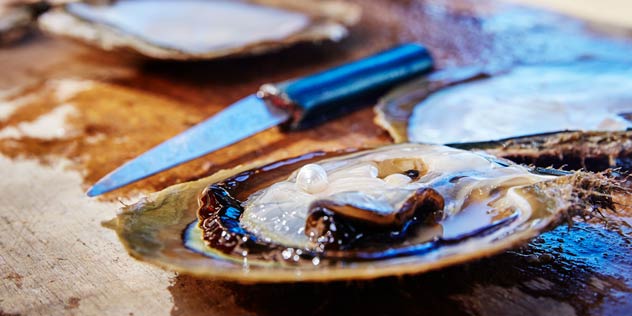
The highway from Broome to Cygnet Bay is surprisingly decent, but it’s the unexpected obstacles that keep things interesting – roos, emus, longhorn bulls, wandering donkeys, a pack of dingoes, all doing their part to elevate my stress levels.
After the rugged austerity of the Dampier Peninsula, Cygnet Bay Pearl Farm emerges like a tropical Brigadoon – a mirage of lushness seemingly in the middle of nowhere. Cheery sun-touched tourists wander about in Hawaiian shirts, cocktails in hand. There’s an infinity pool, a chic restaurant, and an air of relaxed luxury. Cygnet Bay, Australia’s oldest pearl farm since 1946, blends traditional Indigenous knowledge with modern techniques to produce some of the world’s most exquisite South Sea pearls. But running late, I’m in no mood to lounge. I plead with anyone who’ll listen to take me out to meet Rosanna Angus, my First Nations guide for the Oolin Sunday Island Tour.
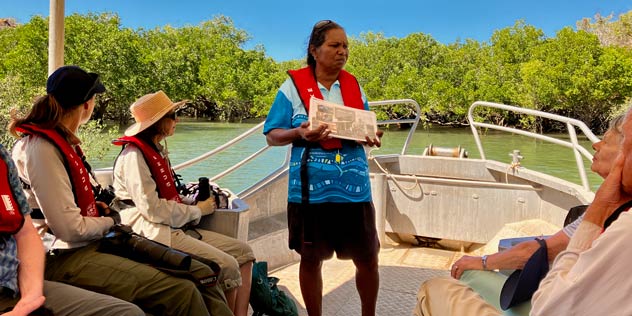
Moments later, I find myself aboard an aqua duck (needed for Broome’s long tides), skimming across long tidal flats, and flying over sapphire-blue water.
Rosanna’s tour is a standout experience; a narrative boat journey that winds through the stunning Kimberley geography, with its jagged cliffs layered like pages of an ancient, weathered book. The adventure culminates in a refreshing swim off a secluded island. After our dip, we find ourselves sitting cross-legged with her on the sandy shore, sharing ‘Dampier damper’ and a cuppa.
As we sip our tea, the amiable Rosanna takes us on yet another journey, this time into the rich and often poignant history of the mission on Sunday Island. Her storytelling is as vivid and compelling as the landscape around us, peeling back layers of history as deep and complex as the sea before us.
During the afternoon’s pearl tour our guide deftly opens an oyster, and there, nestled inside, is a gleaming pearl. It’s like a conjurer’s trick.
Dinner in Cygnet’s restaurant is excellent, a delightful surprise after the day’s salt-encrusted adventures. And the lychee martini? Easily the best this side of anywhere you care to name – smooth, sweet, and strong enough to make you forget about the safari park of roadkill.
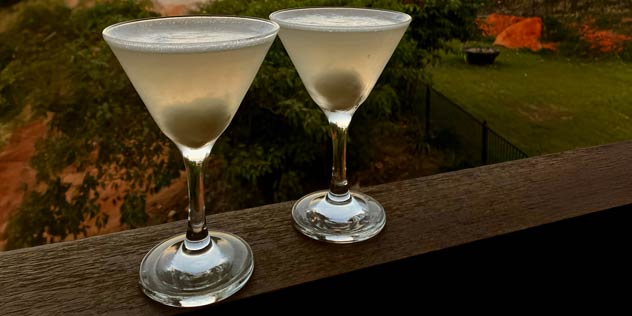
Glamping overnight at Cygnet Bay is an exercise in luxury. The smartly furnished canvas accommodation offers all the comforts of a high-end hotel, with the bonus of being right in nature’s lap. At bedtime, the soothing soundtrack of birds lulls you to sleep.
The following morning, we make our way to the Aboriginal community of Lombadina. Recognised as one of Australia’s top 10 First Nations cultural experiences by Travel Australia, Lombadina is a vibrant community dedicated to self-sufficiency through a range of innovative measures.
Here, we’re met by Bud, a softly spoken guide who leads us to one of the most fascinating sights – a Catholic church with a unique bark roof dating back to 1901. Beside it stands the priest’s rustic corrugated-iron clad accommodation, a humble abode that evokes the isolation of these outback missionaries.
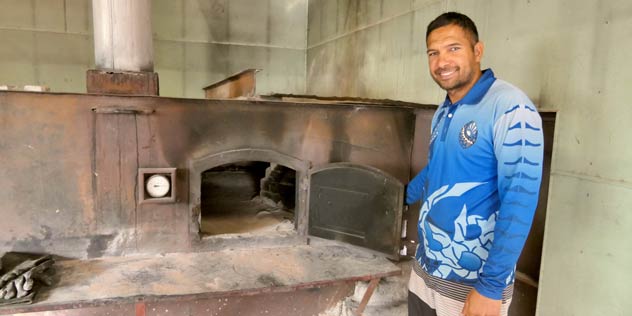
At the Lombadina local arts and crafts store, we discover intricately carved pearl shells, beautiful pendants, hand-carved bowls, and boomerangs – all expertly crafted by local artists using materials sourced directly from the land. This isn’t just a shop, it’s a gallery of living culture, offering a tangible connection to the stories and skills passed down through generations. Naturally, I treat my wife to a $10 ‘pearl’ bracelet 10. Reckless, I know, but I’ll have it insured.
Our real purpose is to see Lombadina’s famous ‘ancient footprints’. These sacred imprints, over 6000 years old and preserved in stone, tell a story that stretches back millennia to the Bardi people and their ancestral heritage. Each footprint is a step back in time, a reminder of the rich, unbroken history of this remarkable land.
We return the HiLux to Broome Broome and there’s no scrutinising looks and no paperwork; the staff barely give the car a second glance. They’re so relaxed, you’d think we were returning a beach towel. Yet another example of the laid-back vibe that typifies the Broome experience.